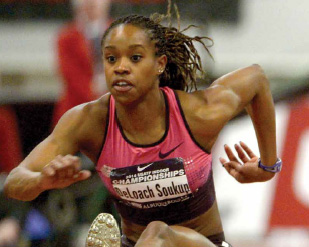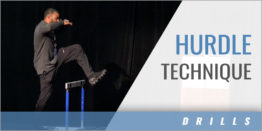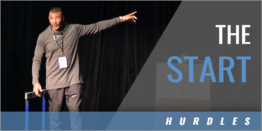| Straighten Up: The Importance of Proper Posture and the Quality of Stiffness in Sprinting |
| By: Karim Abdel Wahab
Originally Published in: Techniques Magazine Provided by: USTFCCCA
Proper posture is the platform for applying force. Sprinters with high strength levels that aren't capable of attaining proper posture won't see much of their strength in the weight room carry over to the track. Without proper posture sprinters won't be able to perform correct sprinting mechanics thus won't be able to take advantage of their strength levels. Poor sprinting posture leads to waste of force. I'm going to go further to stress my point and say that sprinters won't see the fruit of Sir Isaac Newton's third law of motion take place in their performance unless proper posture and mechanics are attained. I usually use the example of sprinting in quicksand with athletes that aren't holding proper posture while sprinting. Another analogy to use with your athletes to illustrate the point is "trying to fire a canon off of a canoe," an equally ineffective undertaking. Proper posture provides a solid platform where force can be applied effectively and efficiently, resulting in a successful link between strength levels developed in the weight room and sprinting on the track. During sprinters' ground contact, the body joints go through a degree of amortization where the joints give and a stretch is placed on the muscles resulting in a stretch shortening effect allowing sprinters to overcome the gravity forces and take advantage of the muscular system free stored energy. A tall sprinting body posture results in a proper and efficient force application by minimizing the collapsing at ground contact in the ankles, knees and hips joints. Too much amortization at ground contact leads to longer ground contact times and less productive impulse at ground contact, which is a great disadvantage for successful sprinting. The vertical movement of an elite sprinter's center of mass following touchdown occurs higher and sooner than slower athletes. A proper tall body posture provides a level of stiffness at the sprinters joint and muscular systems where healthy and productive levels of amortization can take place. Sprinters must have fast eccentric force generating capacity at ground contact to ensure that joints have proper but not excessive amortization at each contact. This fast eccentric force and stiffness at ground contact allows the world's best male sprinters to apply as much as 5 times their bodyweight in force to the ground in single support in under 1/10th of a second. In 1996 former Italian track and field national team head coach Elio Locatelli published a research article in the IAAF magazine, New Studies In Athletics titled "The importance of anaerobic glycolysis and stiffness in the Sprints (60, 100 and 200 meters)." Locatelli concluded from his research that 1) the maintenance of speed is a function of stiffness and 2) anaerobic glycolysis, during sprint races, is a function of stiffness. Simply this means that proper amortization at ground contact and avoiding excessive collapse of the ankles, knees and hips at ground contact leads to a greater speed maintenance phase and a better speed endurance for short sprinters (60,100,200m). It should be understood that proper posture is a prerequisite to the quality of stiffness coach Locatelli was talking about, and that an ideal impulse at ground contact is a great indicator of the quality of stiffness a sprinter holds. See the Figure 1 for a comparison between the types of impulses at ground contact. Note that impulse of great sprinters looks like a check mark (Maximum force application in the least amount of time during ground contact). TRAINING APPROACH Many coaches spend a tremendous amount of time and effort in the weight room addressing concentric strength qualities with the intent being that these developed concentric strength qualities carry over to successful sprinting, jumping or throwing performance. Coaches and athletes alike get frustrated when they see concentric strength gains in the weight room in relation to body weight but fail to see improvement in competition marks. While concentric strength and maximum strength qualities are fundamental and essential for power development there should be a bridge of drills and exercises that help trans-late and express the strength gained in the weight room to the actual next level performance on the track and on the field. The following section addresses the some guidelines for drills and exercises that will help bridge the gap between concentric strength development in the weight room and actual performance. IMPULSE AND STIFFNESS DEVELOPMENT TRAINING REQUIRES DRILLS AND EXERCISES THAT ENFORCE THE FOLLOWING QUALITIES: Drills that enforce tall body posture. Regardless of whether these drills are designed to target the development of impulse and stiffness for the start and acceleration phase or for max velocity phase, the body posture will have to be tall. Emphasis should be placed on avoiding undesirable excessive joints collapse and maintaining a tall body posture at the max velocity phase while the body is upright and perpendicular with the ground. Drills that target the qualities of static and dynamic stability. Some may argue the importance of static stability for sprinters. The argument is usually based on specificity of training and how static contraction work and static stability don't address the dynamic needs and nature of the skill of sprinting. But if one looks at the components of the stretch shortening cycle, one would see that at the instant immediately before ground contact, static contraction is taking place. This is followed by an eccentric contraction due to the shock of ground contact and the force of gravity and then a concentric contraction to overcome gravity. Static and dynamic stability qualities are great proprioceptive activators that call stabilizing muscles to aid in decreasing undesirable excessive joint col-lapsing at ground. These also help in attaining proper amortization at ground contact which will allow the stretch shortening effect off the ground to be far more effective and productive in terms of force application in and off the ground. From a training progression standpoint, static stability qualities can be addressed earlier in the training plan, while dynamic stability qualities need to be addressed throughout the training plan with volumes, intensities and densities that suit each specific phase of training. Drills that target rapidly decelerating and accelerating the center of mass into and off the ground (Plyometrics) will help the neuromuscular system be developed to perform the proper impulse at ground contact. These drills should be designed to train sprinters, jumpers and throwers to explode from proper joints angles, the kind of angles you look for in competition. This answers the question that many coaches have regarding the specific parameters for plyometric drills that are effective in speed and power development. Coach Dan Pfaff shared in his "Guidelines for the implementation of plyometric training" paper that was published when he was working at LSU, providing several guidelines for the design and implementation of plyometric training. Two of these guidelines are highly related to our topic: "Maximum tension can be obtained by creating a situation which stretches an active muscle rapidly. The faster a muscle is forced to lengthen, the greater the force obtained upon resulting contraction. Most physiologists feel that the rate of pre-stretch is far more important than the magnitude of stretch" "Event specific demands have also sparked research into movement analysis of these exercises. Sport scientists are currently involved with testing to see how angles of takeoff, speed of movement, and force application exhibited during jump training relate to event performance. The more closely one designs a series to the demands of his or her event, the higher the carryover"
FOUR AVENUES CAN BE USED TO DEVELOP PROPER POSTURE AND THE QUALITY OF STIFFNESS: 1 - Postural enforcement form training drills during warm ups "A" skips with arms stretched above the head, enforcing a tall body posture "B" skips done with arms stretched above the head, enforcing a tall body Straight leg bound with arms in front of chest, enforcing a stable core 2 - Postural enforcement form training drills Static/dynamic stability drills during warm down "A" runs done on the long jump runway and through the sand pit. The goal is to stay tall and fight collapsing in the sand. Typically 3 sets are done at the cool down, 3-4 times a week "A" runs and freeze for 2 seconds every three counts, keeping ankles, knees and hips rigged at the moment of freezing while recovering thigh in the air parallel to the ground and perpendicular with the torso. Typically 3 sets are done at the cool down, during each set the athlete freezes 6 times for 2 seconds every three reps of "A" run, done 3-4 times a week 3 - Freeze plyometrics drills progression It's very important to teach athletes the proper way to land before teaching the proper way to jump. Teach them the proper joint amortization at landing to activate proper stiffness quality and to avoid exclusive collapsing at ankles, knees and hips joints. My suggested progression is: Step off box and land on two feet at a good athletic position, freeze for two seconds at proper joint amortization angles mirroring an ideal ground contact joint angles (It is likely that these angles will be greater than what your athletes are used to) Same as first progression but with med ball held in front of the forehead. Same as before but land on one foot without med ball Same as before with med ball 4- High impulse plyometrics and multi-throws Plyometric drills that are done from a tall body posture with short and quick ground contact. Examples being a stationary double leg ankle hop (Pogo) while having minimum amortization at knees, hips and landing flat footed at ground contact to ensure explosive planter flexion off the ground while minimizing ground contact time and avoiding undesirable ankle amortization at ground contact. A progression would be a moving ankle hop, then progress to ankle skips, adding a thigh recovery mirroring sprinting action in a tall posture with a quick and explosive skipping rhythm. Multi-throws that promote exploding from proper joint amortization angles and mirrors specific competition joints angles at ground contact. From a tall body posture with a med ball or a shot. Drop into proper ground contact joint angles and explode with full body extension developing a quick impulses from competition specific joint amortization angles RECOMMENDATIONS AND FINAL NOTE There are many great exercises and drills that can be used to address postural integrity and the quality of stiffness. Presented in this article are just a few examples and progressions that can be utilized in your training plan. Feel free to add or subtract drills and exercises that suit your athletes' need and your logistical situation. Making the warm up and warm down more productive by injecting drills and exercises that contribute to the overall athletic development of your athletes can increase the effectiveness of each and every training session. Studying the technical model of your events and understanding proper amortization joint angles is fundamental in designing highly specific postural integrity drills, plyometrics and power training exercises to help train your athletes to explode from proper joints' amortization angles. The presented drills and ideas in this article can be very effective and instrumental in the development of your sprinters and athletes if addressed on regular basses throughout the training plan. REFERENCES Frederick Hatfield, Ph.D. (1989) Power: A Scientific Approach Dan A. Pfaff Louisiana State University. GUIDELINES FOR THE IMPLEMENTATION OF PLYOMETRIC TRAINING Elio Locatelli, (1996) The importance of anaerobic glycolysis and stiffness in the Sprints (60, 100 and 200 meters). New Studies for Athletics 11:2-3; 121-125, 1996 Frans Bosch HBO BSc and Roland Klomp DRS. MSC (2004) Running Biomechanics and Exercise Physiology (Book and DVDs) Karim Abdel Wahab is in his sixth year at Colorado State where he coaching sprints, hurdles and relays. He is also the personal coach for Janay DeLoach-Soukupin, bronze medalist in the long jump at the 2012 Olympic Games and a silver medalist in the same event at the 2012 World Indoor Championship. Additionally, DeLoach-Soukupin posted a 5th place finish in the 60m hurdles at the 2014 World Indoor Championships and an 8th place finish in the Long Jump at the 2015 World Outdoor Championships. A native of Egypt, he coached Amr Seoud and Anas Beshr to national records in the men's 100,200, and 400m. He has also served as an assistant coach at Northern Colorado and Colorado School of Mines. |




 Proper force application is a prerequisite for faster sprinting, jumping or throwing. Adequate strength levels in relation to sprinters' and jumpers' body weight is a great asset for successful performance only if the strength developed in the weight room was successfully carried over to the track or to the field and translated to better performance. Research showed that sprinters moving at 11.1 m/s exerted 26 percent more mass-specific force into the ground compared to athletes running at 6.2 m/s (Weyand, Sternlight, Bellizzi, & Wright, 2000). Additional research from Weyand, Sandell, Prime, & Bundle demonstrated that faster sprinters also produce greater amounts of force in significantly less time, resulting in shorter ground contact times (2010). The top male sprinters in the world are on and off the ground in less than 0.09 seconds when sprinting at top end speed. The top females take just slightly longer.
Proper force application is a prerequisite for faster sprinting, jumping or throwing. Adequate strength levels in relation to sprinters' and jumpers' body weight is a great asset for successful performance only if the strength developed in the weight room was successfully carried over to the track or to the field and translated to better performance. Research showed that sprinters moving at 11.1 m/s exerted 26 percent more mass-specific force into the ground compared to athletes running at 6.2 m/s (Weyand, Sternlight, Bellizzi, & Wright, 2000). Additional research from Weyand, Sandell, Prime, & Bundle demonstrated that faster sprinters also produce greater amounts of force in significantly less time, resulting in shorter ground contact times (2010). The top male sprinters in the world are on and off the ground in less than 0.09 seconds when sprinting at top end speed. The top females take just slightly longer.



